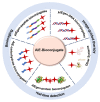Near-Infrared-Emissive AIE Bioconjugates: Recent Advances and Perspectives
- PMID: 35745035
- PMCID: PMC9229065
- DOI: 10.3390/molecules27123914
Near-Infrared-Emissive AIE Bioconjugates: Recent Advances and Perspectives
Abstract
Near-infrared (NIR) fluorescence materials have exhibited formidable power in the field of biomedicine, benefiting from their merits of low autofluorescence background, reduced photon scattering, and deeper penetration depth. Fluorophores possessing planar conformation may confront the shortcomings of aggregation-caused quenching effects at the aggregate level. Fortunately, the concept of aggregation-induced emission (AIE) thoroughly reverses this dilemma. AIE bioconjugates referring to the combination of luminogens showing an AIE nature with biomolecules possessing specific functionalities are generated via the covalent conjugation between AIEgens and functional biological species, covering carbohydrates, peptides, proteins, DNA, and so on. This perfect integration breeds unique superiorities containing high brightness, good water solubility, versatile functionalities, and prominent biosafety. In this review, we summarize the recent progresses of NIR-emissive AIE bioconjugates focusing on their design principles and biomedical applications. Furthermore, a brief prospect of the challenges and opportunities of AIE bioconjugates for a wide range of biomedical applications is presented.
Keywords: NIR emission; aggregation-induced emission; bioconjugates; biomedical applications.
Conflict of interest statement
The authors declare no conflict of interest.
Figures








Similar articles
-
Aggregation-Induced Emission (AIE) Dots: Emerging Theranostic Nanolights.Acc Chem Res. 2018 Jun 19;51(6):1404-1414. doi: 10.1021/acs.accounts.8b00060. Epub 2018 May 7. Acc Chem Res. 2018. PMID: 29733571
-
Recent Advances in Aggregation-Induced Emission Bioconjugates.Bioconjug Chem. 2025 Apr 16;36(4):609-626. doi: 10.1021/acs.bioconjchem.5c00036. Epub 2025 Apr 1. Bioconjug Chem. 2025. PMID: 40167757 Review.
-
In Vivo Fluorescence Imaging-Guided Development of Near-Infrared AIEgens.Chem Asian J. 2023 Mar 1;18(5):e202201251. doi: 10.1002/asia.202201251. Epub 2023 Jan 23. Chem Asian J. 2023. PMID: 36637344 Review.
-
High-Performance Quinoline-Malononitrile Core as a Building Block for the Diversity-Oriented Synthesis of AIEgens.Angew Chem Int Ed Engl. 2020 Jun 15;59(25):9812-9825. doi: 10.1002/anie.201913249. Epub 2020 Mar 6. Angew Chem Int Ed Engl. 2020. PMID: 31725932 Review.
-
Aggregation-Induced Emission: Recent Advances in Materials and Biomedical Applications.Angew Chem Int Ed Engl. 2020 Jun 15;59(25):9868-9886. doi: 10.1002/anie.202000845. Epub 2020 May 7. Angew Chem Int Ed Engl. 2020. PMID: 32128951 Review.
Cited by
-
A Novel Bifunctional Nanoplatform with Aggregation-Induced Emission Property for Efficient Photodynamic Killing of Bacteria and Wound Healing.Infect Drug Resist. 2022 Dec 14;15:7351-7361. doi: 10.2147/IDR.S391272. eCollection 2022. Infect Drug Resist. 2022. PMID: 36540099 Free PMC article.
-
Synthesis and Characterization of Tetraphenylethene AIEgen-Based Push-Pull Chromophores for Photothermal Applications: Could the Cycloaddition-Retroelectrocyclization Click Reaction Make Any Molecule Photothermally Active?Int J Mol Sci. 2023 May 13;24(10):8715. doi: 10.3390/ijms24108715. Int J Mol Sci. 2023. PMID: 37240061 Free PMC article.
-
Background-Quenched Aggregation-Induced Emission through Electrostatic Interactions for the Detection of Poly(ADP-ribose) Polymerase-1 Activity.Molecules. 2023 Jun 14;28(12):4759. doi: 10.3390/molecules28124759. Molecules. 2023. PMID: 37375313 Free PMC article.
-
Tuning Photophysical Properties via Positional Isomerization of the Pyridine Ring in Donor-Acceptor-Structured Aggregation-Induced Emission Luminogens Based on Phenylmethylene Pyridineacetonitrile Derivatives.Molecules. 2023 Apr 6;28(7):3282. doi: 10.3390/molecules28073282. Molecules. 2023. PMID: 37050045 Free PMC article.
-
Synthesis of Side-Chain Liquid Crystalline Polyacrylates with Bridged Stilbene Mesogens.Molecules. 2024 Nov 4;29(21):5220. doi: 10.3390/molecules29215220. Molecules. 2024. PMID: 39519860 Free PMC article.
References
Publication types
MeSH terms
Substances
Grants and funding
- 52122317, 22175120/the National Natural Science Foundation of China
- RCYX20200714114525101, JCYJ20190808153415062, JCYJ20190808142403590/the Developmental Fund for Science and Technology of Shenzhen government
- 2020B1515020011/the Natural Science Foundation for Distinguished Young Scholars of Guangdong Province
LinkOut - more resources
Full Text Sources
Miscellaneous

